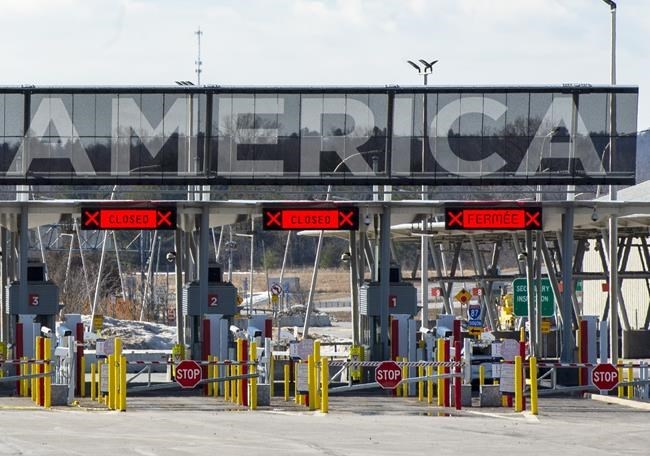WASHINGTON — Canada and the United States should seize the opportunity presented by the global COVID-19 crisis to develop and modernize the way they operate their shared frontier, experts suggested Tuesday as Prime Minister Justin Trudeau warned that the novel coronavirus would likely keep travel restrictions in place for at least the next few weeks.
Canada is still very much in the control-and-contain phase of its efforts to stop the spread of COVID-19, and won't be able to consider even a partial return to normality for several more weeks, Trudeau said as the conversation in the U.S. foreshadowed a thorny, acrimonious battle over when states will, as opposed to should, begin opening their doors.
"We recognize that people are eager to know when we'll get into the next phase and be able to loosen some of the restrictions on work, on school," Trudeau said.
"In regards to the American border, travel restrictions are going to remain extremely important in terms of containing the spread of COVID-19 in Canada, and we're going to continue to work with the Americans and people around the world to ensure that we continue with these restrictions."
The federal government, like countless others around the world, has imposed stringent limits on arrivals into Canada, cutting the number of international flights and directing those that remain to major airports where passengers can be screened for signs of infection.
In fact, the governing Liberals tightened those restrictions Tuesday, requiring anyone arriving in Canada to self-isolate in a government-funded hotel room if they can't demonstrate they have a safe and suitable plan and venue to do so themselves.
But the impossibly intertwined, multibillion-dollar trade and commercial relationship between Canada and the U.S. demanded a different approach at the shared border, where non-essential travel is forbidden in both directions but trucks laden with goods and raw materials, as well as people who live and work on opposite sides, are still able to cross.
That display of pandemic diplomacy has emerged as a "bright spot" in an otherwise bleak international landscape, said Alan Bersin, the former chief diplomatic officer in the U.S. Department of Homeland Security's policy office.
Unlike during the aftermath of 9/11, which saw the U.S. slam the border shut in an urgent effort to block a nebulous and ill-defined terrorist threat, the two countries instead worked together to reach an arrangement of mutual benefit — all the more remarkable, he said, considering an "epidemiological analysis" likely would have argued for a total shutdown.
"Essentially what we ended up with was a North American approach to border crossing," Bersin said during a Wilson Center panel discussion evaluating the effectiveness and fallout from the border restrictions.
"The way in which the governments have handled it have set the stage for actually going much further."
More recent developments, including an agreement to let U.S.-based 3M export medical face masks to Canada and export rules from the Federal Emergency Management Agency that allow pre-existing export arrangement to continue, also augur well.
Given that geography has thrust the three countries together, COVID-19 could well be a chance to consider more practical ways of enforcing their national boundaries, Bersin said — an idea that has been gaining purchase in recent years in the face of geopolitical realities in China and elsewhere, as well as the newly ratified U.S.-Mexico-Canada Agreement.
"I think we want to use the COVID-19 experience as a great platform to think further about how we evolve this vision of North America and North America led by Canada, Mexico and the United States, but involving a much larger region ... a North America that reaches from Colombia to the Arctic and from Bermuda to Hawaii," he said.
"That's the future, I think, in which North American leadership can best be maintained."
Bersin said he expects the next hurdle for the two countries to clear will be dealing with the small army of health-care professionals who live in border cities like Windsor, Ont., but cross into the U.S. each day to do battle on the front lines against COVID-19 at overwhelmed American hospitals.
"There's some pressure from both sides of the border, frankly, in the interests of containing the COVID-19 virus, of not permitting people to go back and forth, particularly health-care workers," he said.
"I think the example that was set in the 3M case ... will actually lead to a sensible resolution of this latest issue."
The 30-day border agreement is due for renewal before April 21.
With invisible pathogens now high on world's security-threat hit lists, technology will soon play a key role, predicted Solomon Wong, a management consultant in the aviation and transportation industry.
Indeed, that's already happening in China, where recently resumed air travel now requires travellers to submit to a smartphone scan that provides intimate location-based data about where the person has been and whether they have likely been exposed to the virus.
The privacy issues inherent in such a system are self-evident, said Wong.
"The conversation on individual privacy versus public good — those are some things that we're going to go through in terms of both the thirst for solutions, but also some creative ideas that I know folks in Canada and the United States will keep their sharp pencils on in terms of how this actually comes to fruition."
This report by The Canadian Press was first published April 14, 2020.
— Follow James McCarten on Twitter @CdnPressStyle
James McCarten , The Canadian Press




